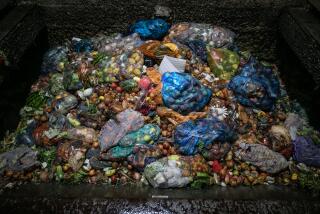ASIA : S. Korea’s Strategy for Energy Conservation Is ‘Think Poor’
- Share via
SEOUL — South Korea does not have an energy crisis, insists the Korea Electric Power Corp., or KEPCO.
Nevertheless, employees at the company--which supplies electricity nationwide to what is now the world’s 12th-largest economy--are bracing themselves for another summer without air conditioning in their own headquarters.
Last year, the government-run company set a policy of keeping the temperature in its offices at 79 degrees during the summer. “But, in fact, we didn’t turn on the air conditioning at all,” even with an exceptionally long streak of 90-degree-plus days, said Kim Keuk Bae, a KEPCO spokesman.
“We helped contribute to the public consciousness of the need to save energy,” he recalled proudly, predicting that the company will refrain from cooling its offices again this year.
Such Spartan endurance hardly raises an eyebrow in South Korea, which has achieved spectacular economic growth and at the same time has managed to transform conservation efforts launched at the time of the first oil crisis in 1973 into a kind of permanent “think poor” energy policy.
To the idea of reading a newspaper by the light of a 40-watt bulb, Koreans apply the thinking, “That’s good enough,” said Koh Jung Shik, director of conservation at the Ministry of Trade, Industry and Energy.
At the sight of an escalator shut down to save energy, they think, “We are a poor country with no natural resources,” KEPCO’s Kim said.
The capital’s subways and subway stations are dimly lighted. Streets and sidewalks are poorly illuminated at night. The lobby in the giant Lotte Hotel is so gloomy that identifying a friend at a distance is difficult. Elevators in many buildings stop only at alternate floors. Older buildings don’t have elevators at all.
Central controls keep half of the 40-watt fluorescent ceiling lights off in most office buildings--KEPCO’s included. Most lamps are designed for bulbs of 60 watts or less. The most popular reading lamp at one downtown lighting shop is a 50-watt halogen lamp, which generates light equivalent to that of a regular bulb of about 80 watts, a salesman said. Fewer than 10% of customers buy 100-watt reading lamps, he added.
Most astounding, TV stations shut down during most of the day on weekdays, broadcasting only from 6 a.m. to 10 a.m. and again from 5:30 p.m. to midnight, Monday through Friday.
Yet even as South Korea approaches the status of an advanced industrialized nation--it has applied for membership in the Organization for Economic Cooperation and Development--none of these conservation measures have stirred any complaints from the public.
“In Korean culture, people who tolerate the hardships of nature and the environment as it exists are highly respected,” Koh said.
Daylight-saving time has proved the only exception to the unquestioning acceptance of conservation measures. It was implemented in 1988, not primarily with conservation in mind but to maximize TV revenues from the Olympic Games.
But the time change proved unpopular with average Koreans, who complained that their bosses forced them to spend an extra hour at work, and it was abolished soon after the Olympics ended.
*
Last year, when peak summer demand for power was only 3% less than capacity, “we had a close call,” Koh admitted. The breakdown of a single power plant would have caused a widespread brownout, he said. Occasional power outages have occurred in limited areas in recent years, he added.
KEPCO expects to go through this summer with 8.2% more power capacity than will be demanded at peak periods, which is slightly below its desired 10% flexibility, Kim said.
All the same, to keep fueling economic growth that this year is hovering around 10%, South Korea must double its capacity to supply electricity within a decade. That means building 72 power plants, including 14 new nuclear units, by the year 2006. Ten nuclear power plants are in operation, and six more are under construction.
More to Read
Sign up for Essential California
The most important California stories and recommendations in your inbox every morning.
You may occasionally receive promotional content from the Los Angeles Times.










